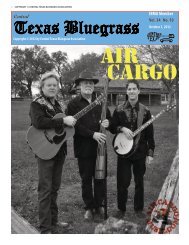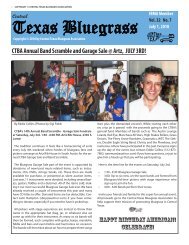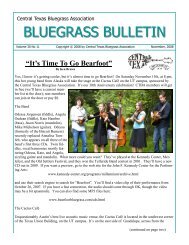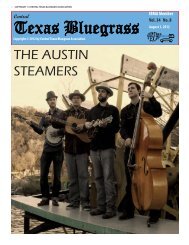a Little: Red Haired Boy (Dobro) - Central Texas Bluegrass ...
a Little: Red Haired Boy (Dobro) - Central Texas Bluegrass ...
a Little: Red Haired Boy (Dobro) - Central Texas Bluegrass ...
Create successful ePaper yourself
Turn your PDF publications into a flip-book with our unique Google optimized e-Paper software.
14 COPYRIGHT © CENTRAL TEXAS BLUEGRASS ASSOCIATION<br />
spent in New York, there were a few bluegrass bands. In fact Bob Grant who with the Bad Livers in the 90’s,<br />
moved to New York and instigated a lot of bluegrass activity. I got a lot of experience playing with him.<br />
Mostly I played with songwriters and bands. I played dobro or steel with those kind of musicians which was<br />
good because I learned how to do a lot of good things besides just play bluegrass. But the Grassy Knoll <strong>Boy</strong>s<br />
is the place where I really got to play serious bluegrass on a regular basis. I would do it again. I would do<br />
more of it. It was a lot more fun being in a band than being in a pickup situation because we worked long<br />
on the songs, we worked long on the singing, we thought a lot about the arrangements, the choreography<br />
to work around the microphone. It was the first time I had been in a band in a really long time, I had done<br />
so much freelancing. I don’t know if I would do it again without those circumstances and then now I have<br />
a couple of kids and I just can’t do every gig that comes up because I have so much more to do and I’ve got<br />
them to take care of. I didn’t stop playing because I was sick of playing bluegrass. I quit playing in the Grassy<br />
Knoll <strong>Boy</strong>s because I had a kid, my wife was in grad school, Alex (Rueb) was working at Collins…band stuff.<br />
Some of our readers are dobro players. What advice would you give people starting out, how would that advice<br />
be different for intermediate level players to take their playing to the next level?<br />
I would say that if you possibly can as a beginner try to get with a more experienced player and sit down<br />
with them and watch what they are doing. I learned to play from the great multi-instrumentalist, he’s in<br />
Nashville now, he was in New York then, Fats Kaplan. He played with Kevin Welch and Karen Cane Hatch for<br />
a long time. The very first lesson I had. He gave me a set of fingerpicks and showed me how to bend them<br />
so they work and sound good. Then I had a couple of lessons with Stacy Phillips within that same year. He<br />
showed me how to do a pull-off so you snap the bar and it releases the string instead of just lifting the bar<br />
off and how to do a slant. I learned a lot from his book. I finally met him after I had worked on his book for<br />
almost a year. Then, I was teaching at a workshop where he was going to come in for a week and I had the<br />
week off so I just crashed his class. He was interested in Hawaiian music and playing all kinds of world music<br />
on the dobro and I was like, can you just show me how to play like Josh Graves? He sat there and sighed and<br />
said, OK, it’s this scale and this scale and you go up there and do this…for like ten minutes. I went home and<br />
worked on those ten minutes for a year. He really could show you everything you needed to know in about<br />
ten minutes but it was a couple of years to work it all out. But he showed me how to do the hammer-on and<br />
pull-off and I went back to his book and I had circled that chapter with a big question mark. So those are<br />
things that are hard to describe so I would say that if you can get someone to show you those techniques,<br />
right in front of you, that can be a huge help because those are the things that are mysterious.<br />
Does that apply to all levels?<br />
I think if you’ve gotten to a certain point you know how to do those things. You know how to hold the picks,<br />
snap the bar, but for more intermediate players. I would say musicianship things. Learn the notes on the<br />
fingerboard, learn chord theory so you can understand why these shapes work, practice with a metronome.<br />
That’s the most important thing. Practice with a freaking metronome. If you are going to play standing up;<br />
practice standing up. Those two things. Otherwise you will lose half of your ability as soon as you stand up.<br />
Especially when you get on stage, you’re already nervous, your hands are shaking, and everything is faster<br />
than it’s supposed to be. That’s great advice.<br />
Can you talk a minute about the things other teachers can do to get connected with their students online?<br />
The access is so simple now. There’s no reason why you can’t post some simple little videos of yourself and<br />
put them online. You don’t even need a web site to get started. You can put them on Facebook, on YouTube.<br />
This is a round about way of answering the question but when I first started writing columns for Guitar Player<br />
I had a fantastic editor, Andy Ellis, who lives in Nashville now. He’s a freelance writer and is doing great. He<br />
has a guitar radio show. He’s a great musician too. He used to say, you’ve got one page for your column, 200









